What can I do to improve the smoothness of scrolling in Window 7?
Here are some suggestions that may improve your computer's scrolling smoothness. Click the suggestion to go to details.
NOTE: See also Improving TeleScript Software in Window 11 (also applies to Win 10)
2. Lower the color depth of the display.
3. Disable competing applications.
4. Check your controller cable and/or serial/USB driver.
5. Check individual video card settings.
NOTE: also read Jim Stringer's blog article on Smooth Scrolling at: Jim's Teleprompter Blog
1. Be certain that "Font Smoothing" is disabled. How you do this depends upon which TeleScript software you are using.
TeleScript AV
From the main menu, select "Tools/Preferences". Click the "Prompter" tab and check the box beside "Disable font smoothing". Click OK and re-test the scrolling smoothness.
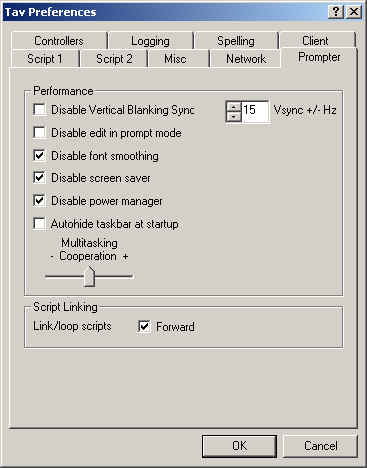
TeleScript Pro
From the main menu, select "Tools/Options". Click the "Prompter" tab. Check the box beside "Disable font smoothing." Click OK and re-test scroll.
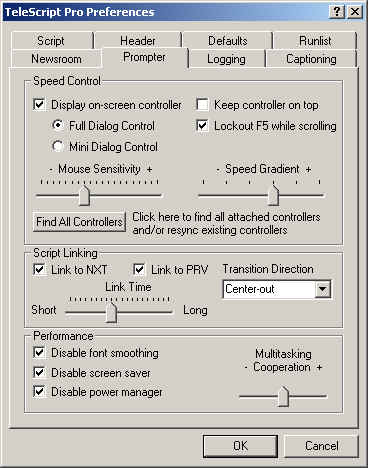
2. Lower the color depth of your display from 32bit color to 16bit color. How you do this depends upon a) the version of Windows you are using, and; b) the  type of video card. For specifics on how to set your video card, see the manufacturer's documentation.
Windows XP
From the Start menu, select "Control Panel / Display". Alternately, right click on the desktop and select "Properties" from the dropdown menu. Click the "Settings" tab, and in the combo box marked "Color quality", select "Medium (16bit)". Click OK and re-test scroll.
Note: you may also improve scrolling smoothness by selecting a lower "Screen resolution", however do this only if resetting the color quality doesn't produce sufficient smoothness.
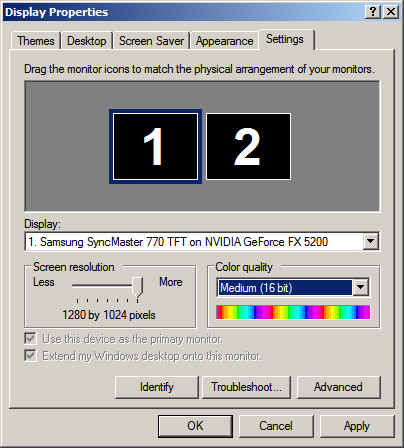
Windows Vista
From the Start menu, select "Control Panel / Personalize" and click "Display Settings" in the browser page to display the dialog below. Under "Colors:", select "Medium (16 bit)" and click OK. Re-test scrolling.
NOTE: You may also improve scrolling by lowering the display "Resolution". Do this only if lower the color quality doesn't sufficiently improve scrolling.
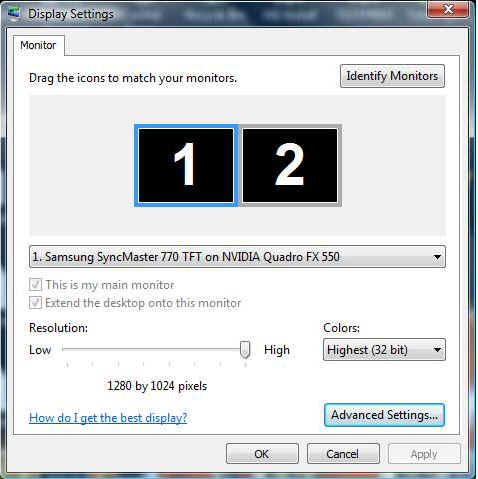
Windows 7
Right click on the desktop and select "Select resolution" to display this brower type dislog:
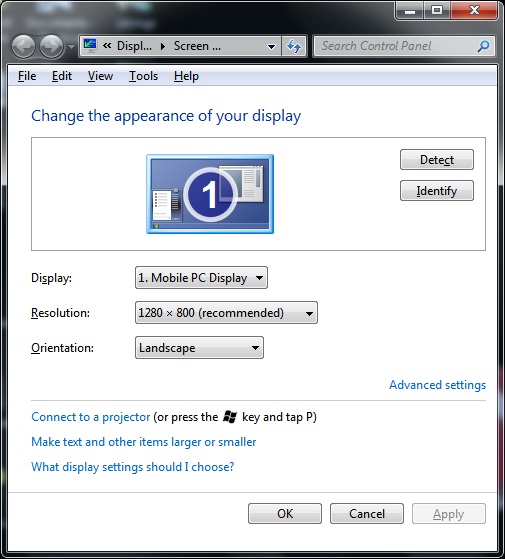
Click the "Advanced settings" link (middle right) to display the advanced settings dialog. Click the Mointor tab.
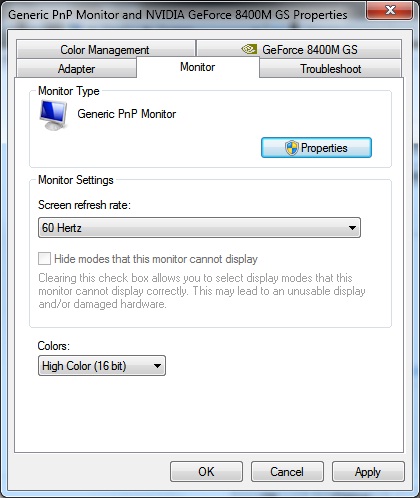
Beneath "Colors:" (lower right), select "High Color (16 bit)" and click "OK" to close all the display properties windows. Re-test scroll.
NOTE: You may also set the display to a lower resolution, but do this only if resetting the color quality doesn't result in sufficient smoothness.
3. Disable competing applications and drivers.
All version of the Windows operating system are multitasking; that is, they allow multiple "processes" to run in a cooperative setting that make the apps appear to be engaged simultaneously. In reality, the system runs one process at a time, constantly passing control from one process to another. The fewer application that are running in this cooperative environment, the more time each process has to tend to its business.
To view the applications processes that are running at any given time on your computer, press <Ctrl + Alt + Delete> and select "Task Manager" (if the computer doesn't automatically start Task Manager). Click on the "Applications" tab; then click on the "Processes" tab. This may give you an appreciation of the daunting task faced by a real time application such as TeleScript AV or TeleScript Pro. If in Processes view, the column, "CPU Time" is not displayed, select "View/Select Columns.." and check "CPU Time", then click OK. In Task Manager, you may sort the processes by clicking on the header. Click "CPU Time" and note which processes have cumulatively used the most processor time.
MSCONFIG is a system tool that allows you to controlling which application and drivers are installed when you start your computer. To run MSCONFIG, select "Start/Run". In the run dialog, type "MSCONFIG" and press OK. Click on the "Services" tab.
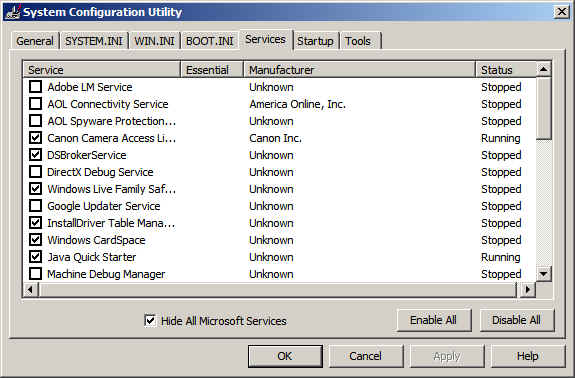
Simplify the display by checking the box that reads "Hide all Microsoft Services". This will display only the drivers and services that are installed by third parties. Compare the System Configuration display with the Task Manager process display to determine which of this installed services may be usurping the most processor time. Unchecking an item will disable the item the next time your machine is booted.
Now, click the "Startup" tab.
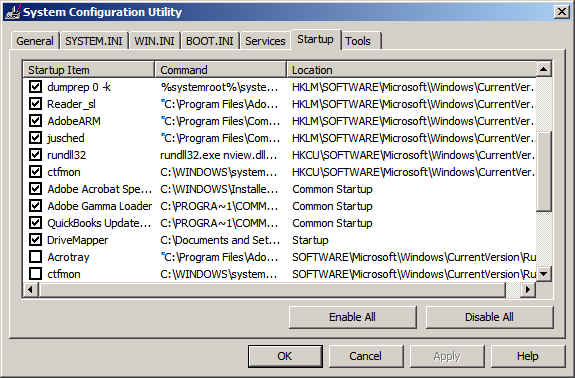
Each one of the application that is installed in the Startup group will expect processor time. Compare this display to the Process display in Task Manager. Even application such at "QuickBooks Update..." will consume processor time.
Because Services and Startup are specific to your login (user specific), you may want to set up a user account for the Prompter which operates in the cleanest environment possible. When you require maximum scrolling smoothness, you can login to this user account. Setting up user accounts is discussed in detail in the Windows Help system, and on the Internet. Further discussion here is beyond this scope of this help document.
4. Check your contoller, cable and USB/Serial adapter.
In rare instances, a faulty controller, intermittent controller cable or a malfunctioning USB/Serial device or driver, may send spurious information to TeleScript software. This can make scrolling erratic. If you suspect that your controller or some item in the controller chain is at fault, try this:
Remove the controller and restart TeleScript AV or Pro. Enable the on-screen dialog controller:
TeleScript AV: from the menu, select "Tools/Preferences" and click the "Controllers" tab. Under "Dlg Control", click either "Full Dialog Control" or "Mini Dialog Control" and click the box beside "Keep controller on top".
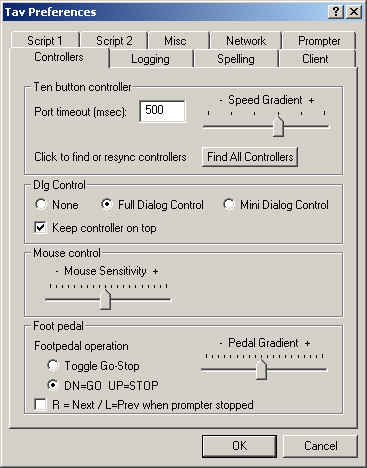
TeleScript Pro: from the top level menu, select "Tools/Options" and click the "Prompter" tab. Check the box beside "Display on-screen controller", select either "Full Dialog Control" or "Mini Dialog Control", click OK.
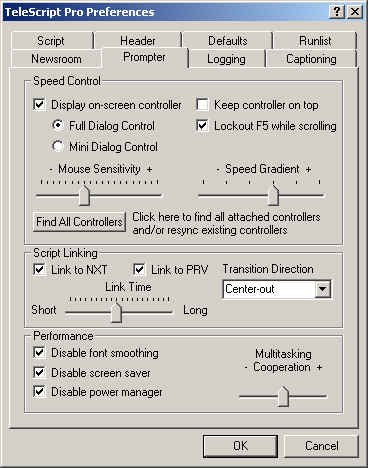
Both the TeleScript Pro and TeleScript AV dialog controls are similar. Pictured below is the TeleScript Pro dialog control.
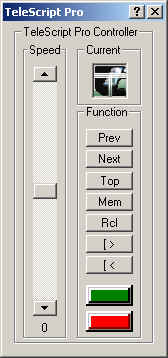
With a script loaded, place your TeleScript software in prompter mode -- <F5> for TeleScript AV, <Alt+F5> for TeleScript Pro. Then click the green "button" on the dialog control and move the Speed slider upwards until the display begins to move. If the display scrolls smoothly using the dialog control, it is evidence that some part of the controller chain is faulty. Contact Telescript technical support for more assistance.
5. Check individual video card settings.
Video cards in today's world are complex and "driver" based as opposed to the "hardware" based systems of the past. Consequently, each video card has many driver settings the may slow down or speed up the display; disable certain features (most notably for prompting, the vertical blanking interrupt must be enabled); alter the presentation... etc.
Most popular manufacturers -- nVidia, ATI, Intel, etc. -- provide control applets to configure the drivers. Because there is no commonality between these applets, consult your manufacturer's documentation for specifics. Make notes about your choices and experiment with various settings.
